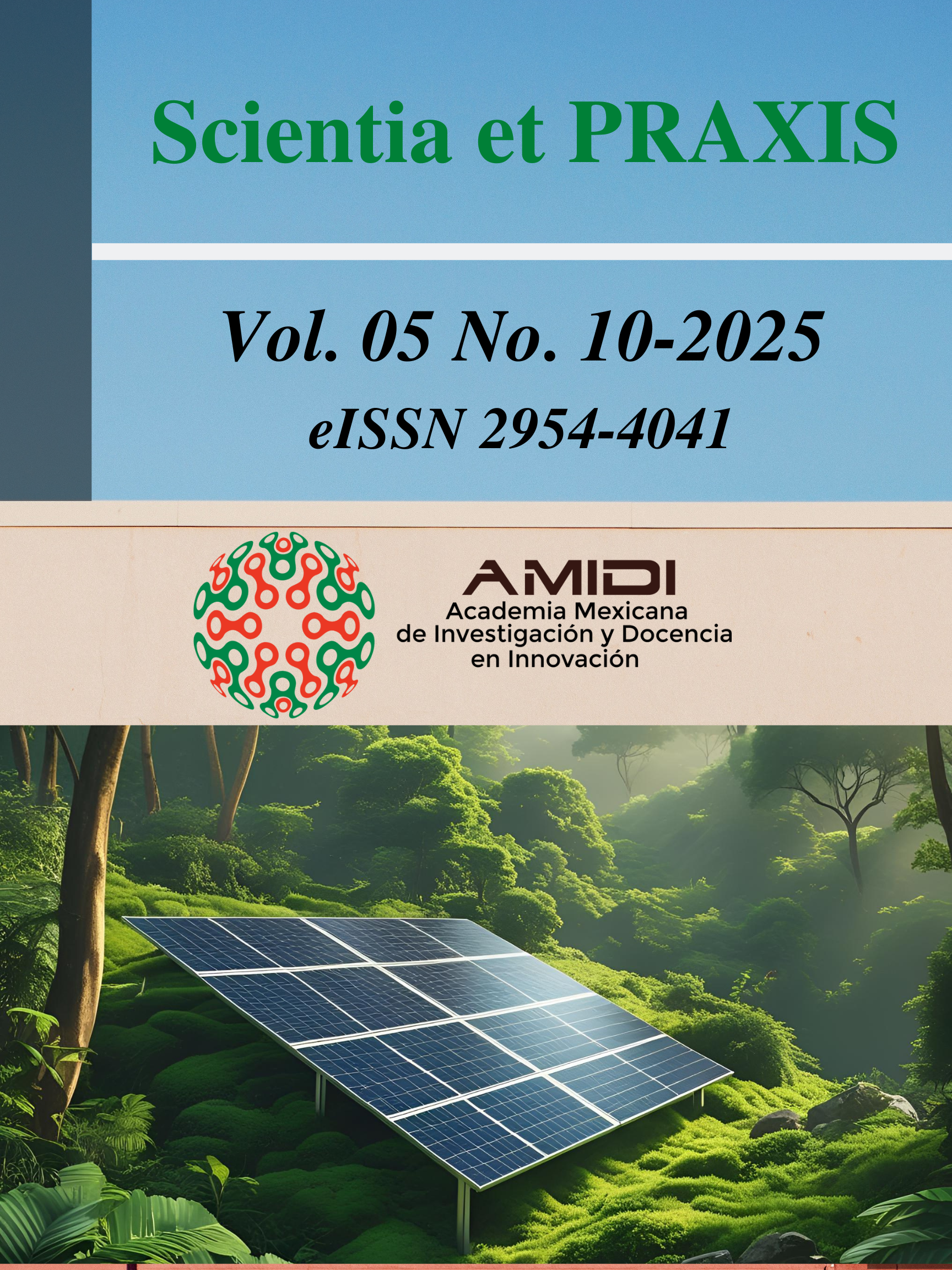Geospatial technologies for mapping natural capital and promoting sustainable agricultural employment in Mexico
DOI:
https://doi.org/10.55965/setp.5.10.a1Keywords:
natural capital index, population employed in the primary sector, geospatial mapping, spatial autocorrelationAbstract
Context. The use of natural capital and the distribution of employment in agriculture and livestock are unequal among Mexican regions. Some of them concentrate on ecological wealth and the employed population (rural-urban), while others show environmental degradation or underutilization of labor.
Problem. There is a lack of research that combines ecological and labor indicators in geospatial maps to support informed decision making. Are there significant spatial patterns between the Natural Capital Index (NCI) and the Principal Economic Location Quotient (PELQ) that allow identifying priority areas for sustainable development?
Purpose. This study analyzes the spatial patterns between natural capital and agricultural employment from a multidisciplinary approach that integrates environmental economics, economic geography, and spatial analysis in Mexico. It seeks to generate innovative knowledge aligned with the 2030 Agenda and the SDGs (8, 13, and 15). It is framed within social and organizational innovation according to the Oslo Manual. It promotes territorial sustainability through interaction between disciplines.
Methodology. This research is quantitative, non-experimental, and exploratory-explanatory, based on spatial and statistical analyses using 2021 secondary census and aggregated data. A geospatial database was built from official environmental and socioeconomic sources. Moran’s binomial index and LISA analysis were applied in R® to identify spatial clusters of consistency between ICN and CLEp, with statistical significance at the 95% confidence level (p ≤ 0.05).
Theoretical and practical findings. Significant positive associations were found in a total of 73 municipalities. High clustering was observed in the Northeast, Central and Southeast regions. The value of natural capital as a productive asset and the usefulness of spatial analyses to guide public policies were confirmed.
Originality. This study integrates environmental and socioeconomic variables from a spatial perspective to generate new applicable knowledge.
Conclusions and limitations. This study proposes an interdisciplinary innovation in territorial planning by integrating environmental and labor variables using spatial tools. Future research should integrate climate and institutional data to improve sustainable policy making.
Downloads
References
Anselin, L. (2001). Spatial econometrics. En A companion to theoretical econometrics (Blackwell Publishing Ltd., pp. 310-330). https://onlinelibrary.wiley.com/doi/10.1002/9780470996249.ch15 DOI: https://doi.org/10.1002/9780470996249.ch15
Brondizio, E. S., Ostrom, E., & Young, O. R. (2009). Connectivity and the governance of multilevel social-ecological systems: The role of social capital. Annual review of environment and resources, 34(1), 253-278. https://doi.org/10.1146/annurev.environ.020708.100707 DOI: https://doi.org/10.1146/annurev.environ.020708.100707
Bugge, M. M., Hansen, T., & Klitkou, A. (2016). What is the bioeconomy? A review of the literature. Sustainability, 8(7), 691. https://doi.org/10.3390/su8070691 DOI: https://doi.org/10.3390/su8070691
Buzzelli, M. (2020). Modifiable areal unit problem. International encyclopedia of human geography, 169-173. https://doi.org/10.1016/B978-0-08-102295-5.10406-8 DOI: https://doi.org/10.1016/B978-0-08-102295-5.10406-8
Cabral, J. J. V., Medina, I. O., & Ortiz, M. H. (2024). Hacia una gestión sostenible del agua en México: Innovación agroecológica y gobernanza policéntrica. Scientia et PRAXIS, 4(8), 1-31. https://doi.org/10.55965/setp.4.08.uady.a1 DOI: https://doi.org/10.55965/setp.4.08.uady.a1
CEPAL; FAO; IICA. (2023). Perspectivas de la Agricultura y del Desarrollo Rural en las Américas: Una mirada hacia América Latina y el Caribe 2023-2024. https://mexico.un.org/sites/default/files/2023-10/IICA-FAO-CEPAL.pdf
Comisión para el Conocimiento y Uso de Nacional la Biodiversidad (CONABIO). (2023). Índice de Capital Natural (ICN). Capital Natural de México. https://www.biodiversidad.gob.mx/pais/capitalNatMex.html
Consejo Nacional de Evaluación de la Política de Desarrollo Social. (2022). Fichas metadato de los indicadores. Fichas metadato de los indicadores. CONEVAL. https://www.coneval.org.mx/Medicion/MP/Documents/PATP/Fichas_metadato_PATP_3era_fase.pdf
Consejo Nacional de Evaluación de la Política de Desarrollo Social (CONEVAL). (2023). Plataforma para el Análisis Territorial de la Pobreza (PATP). https://www.coneval.org.mx/Medicion/Paginas/Plataforma-Analisis-Territorial-de-la-Pobreza.aspx
Costanza, R., de Groot, R., Braat, L., Kubiszewski, I., Fioramonti, L., Sutton, P., Farber, S., & Grasso, M. (2017). Twenty years of ecosystem services: How far have we come and how far do we still need to go? Ecosystem Services, 28, 1-16. https://doi.org/10.1016/j.ecoser.2017.09.008 DOI: https://doi.org/10.1016/j.ecoser.2017.09.008
Czúcz, B., Molnár, Z., Horváth, F., Nagy, G. G., Botta-Dukát, Z., & Török, K. (2012). Using the natural capital index framework as a scalable aggregation methodology for regional biodiversity indicators. Journal for Nature Conservation, 20(3), 144-152. https://doi.org/10.1016/j.jnc.2011.11.002 DOI: https://doi.org/10.1016/j.jnc.2011.11.002
Fotheringham, A. S. (2009). The problem of spatial autocorrelation” and local spatial statistics. Geographical analysis, 41(4), 398-403. https://doi.org/10.1111/j.1538-4632.2009.00767.x DOI: https://doi.org/10.1111/j.1538-4632.2009.00767.x
Fujita, M., Krugman, P. R., & Venables, A. (1999). The spatial economy: Cities, regions, and international trade. https://doi.org/10.7551/mitpress/6389.001.0001 DOI: https://doi.org/10.7551/mitpress/6389.001.0001
Galán, C., Balvanera, P., & Castellarini, F. (2012). Políticas públicas hacia la sustentabilidad: Integrando la visión ecosistémica. CONABIO. https://www.academia.edu/download/49372325/Polticas_pblicas_hacia_la_sustentabilida20161005-894-1wvw7cj.pdf
Instituto Nacional de Estadística y Geografía. (2025). Economía y Sectores Productivos. Producto Interno Bruto. https://www.inegi.org.mx/temas/pib/
Islas, M. N. H., Novelo, A. F., & Serna, M. del C. M. (2024). Desarrollo sostenible a través de la innovación en seguridad alimentaria y hábitos alimenticios en familias marginadas. Scientia et PRAXIS, 4(8), 32-60. https://doi.org/10.55965/setp.4.08.uady.a2 DOI: https://doi.org/10.55965/setp.4.08.uady.a2
Krugman, P. (1991). Increasing returns and economic geography. Journal of political economy, 99(3), 483-499. https://www.jstor.org/stable/2937739 DOI: https://doi.org/10.1086/261763
Krugman, P. (1999). The role of geography in development. International regional science review, 22(2), 142-161. https://doi.org/10.1177/016001799761012307 DOI: https://doi.org/10.1177/016001799761012307
LeSage, J., & Pace, R. K. (2009). Introduction to spatial econometrics (Chapman and Hall/CRC). Chapman and Hall/CRC. https://doi.org/10.1201/9781420064254 DOI: https://doi.org/10.1201/9781420064254
Luna, E. R., & Méndez, J. L. A. (2022). Otontepec; la región y su capital natural. Patrimonio natural del área natural protegida Sierra de Otontepec, Veracruz, México, 49-145. https://doi.org/10.25009/uv.2849.1688 DOI: https://doi.org/10.25009/uv.2849.1688
Martínez-Rodríguez, M. R., Viguera, B., Donatti, C. I., Harvey, C. A., & Alpízar, F. (2017). La importancia de los servicios ecosistémicos para la agricultura Módulo 3. Centro Agronómico Tropical de Investigación y enseñanza (CATIE). https://www.conservation.org/docs/default-source/publication-pdfs/modulo-3-color.pdf?Status=Master&sfvrsn=342df765_3
Mora, F. (2017). Nation-wide indicators of ecological integrity in Mexico: The status of mammalian apex-predators and their habitat. Ecological Indicators, 82, 94-105. http://dx.doi.org/10.1016/j.ecolind.2017.06.030 DOI: https://doi.org/10.1016/j.ecolind.2017.06.030
Moran, P. A. (1948). The interpretation of statistical maps. Journal of the Royal Statistical Society. Series B (Methodological), 10(2), 243-251. http://www.jstor.org/stable/2983777 DOI: https://doi.org/10.1111/j.2517-6161.1948.tb00012.x
Munton, R. (2016). The rural: Critical essays in human geography (University College London, UK). Routledge. https://doi.org/10.4324/9781315237213 DOI: https://doi.org/10.4324/9781315237213
OCDE. (2025). Supply Chain Resilience Review: Navigating Risks. 184. https://doi.org/10.1787/94e3a8ea-en. DOI: https://doi.org/10.1787/94e3a8ea-en
OCDE, Eurostat. (2018). The Measurement of Scientific, Technological and Innovation Activities Oslo Manual 2018 Guidelines for Collecting, Reporting and Using Data on Innovation. OECD publishing, Paris. https://doi.org/10.1787/9789264304604-en DOI: https://doi.org/10.1787/9789264304604-en
OCDE, & FAO. (2017). Guía OCDE-FAO para las cadenas de suministro responsable en el sector agrícola. 88. http://dx.doi.org/10.1787/9789264261358-es DOI: https://doi.org/10.1787/9789264261358-es
Openshaw, S. (1983). The modifiable areal unit problem. Concepts and techniques in modern geography. https://doi.org/10.1002/9781118526729.ch3 DOI: https://doi.org/10.1002/9781118526729.ch3
Organización de las Naciones Unidas (ONU). (2023). Objetivos del Desarrollo Sostenible (ODS). Nueva Agenda para el Desarrollo Sostenible. https://www.un.org/sustainabledevelopment/es/objetivos-de-desarrollo-sostenible/
Pacheco Almaraz, V., Palacios Rangel, M. I., Martínez González, E. G., & Vargas Canales, J. M. (2025). La especialización productiva en el sector agrícola mexicano. Investigación multidisciplinaria en tiempos de Covid-19, 175-184. https://doi.org/10.52501/cc.162.13
Rodríguez-Robayo, K. J., Perevochtchikova, M., Ávila-Foucat, S., & De la Mora De la Mora, G. (2020). Influence of local context variables on the outcomes of payments for ecosystem services. Evidence from San Antonio del Barrio, Oaxaca, Mexico. Environment, Development and Sustainability, 22(4), 2839-2860. https://doi.org/10.1007/s10668-019-00321-8 DOI: https://doi.org/10.1007/s10668-019-00321-8
Secretaría de Agricultura y Desarrollo (SADER). (2023). Sistema de Información Agroalimentaria de Consulta (SIACON-NG). Servicio de Información Agroalimentaria y Pesquera (SIAP). https://www.agricultura.gob.mx/datos-abiertos/siap
Siabato, W., & Guzmán-Manrique, J. (2019). La autocorrelación espacial y el desarrollo de la geografía cuantitativa. Cuadernos de Geografía: Revista Colombiana de Geografía, 28(1), 1-22. https://doi.org/doi: 10.15446/rcdg.v28n1.76919 DOI: https://doi.org/10.15446/rcdg.v28n1.76919
Tellería, J. L. (2005). El impacto del hombre sobre el planeta. Editorial Complutense De Madrid.
Vázquez-Elorza, A. (2021). Regional Wealth with Biodiversity and Socioeconomic Marginality. Scientia et PRAXIS, 1(1), 9-16.
https://doi.org/10.55965/setp.1.01.a2 DOI: https://doi.org/10.55965/setp.1.01.a2
Vesco, P., Dasgupta, S., De Cian, E., & Carraro, C. (2020). Natural resources and conflict: A meta-analysis of the empirical literature. Ecological Economics, 172, https://doi.org/10.1016/j.ecolecon.2020.106633. DOI: https://doi.org/10.1016/j.ecolecon.2020.106633
Xue, Y., & Liu, H. (2024). Influence of Natural Risks and Non-Agricultural Income on Agricultural Trusteeship Decisions in Northeast China. Foods, 13(13), 2024. https://doi.org/10.3390/foods13132024 DOI: https://doi.org/10.3390/foods13132024
Published
How to Cite
Issue
Section
License
Copyright (c) 2025 Ariel Vázquez-Elorza

This work is licensed under a Creative Commons Attribution-NonCommercial 4.0 International License.











